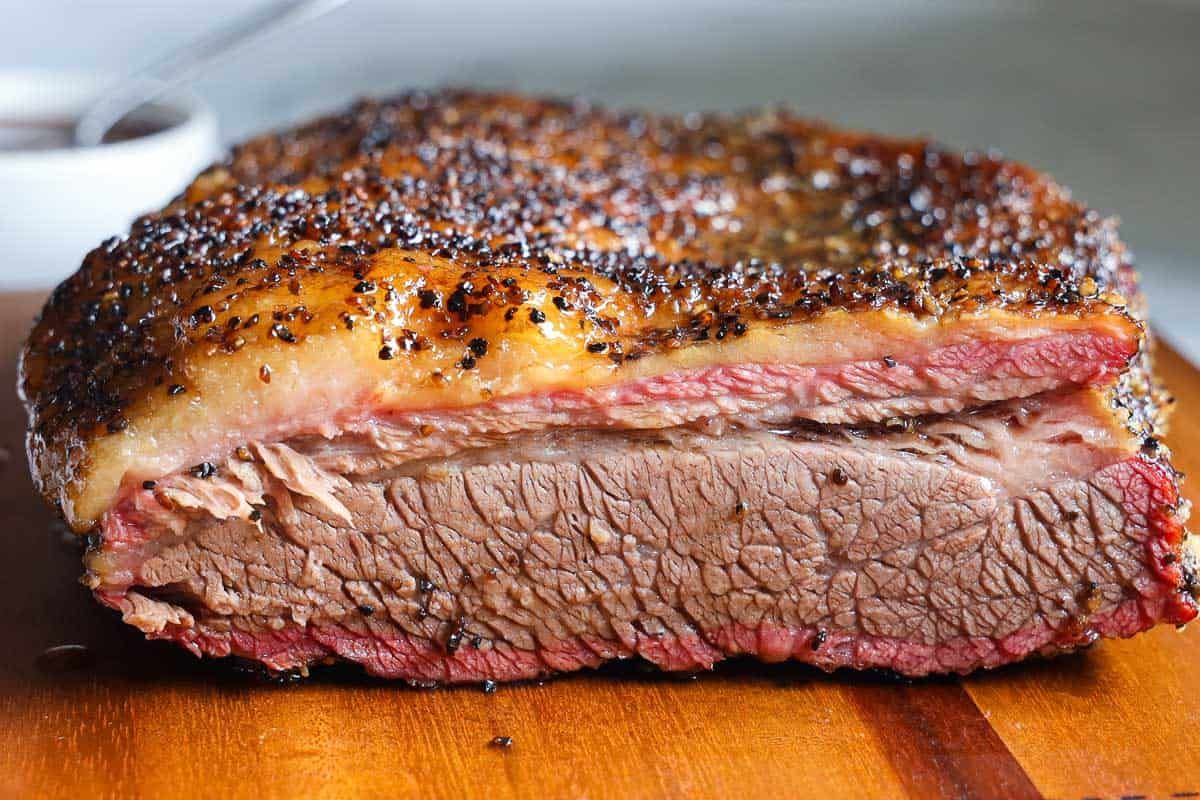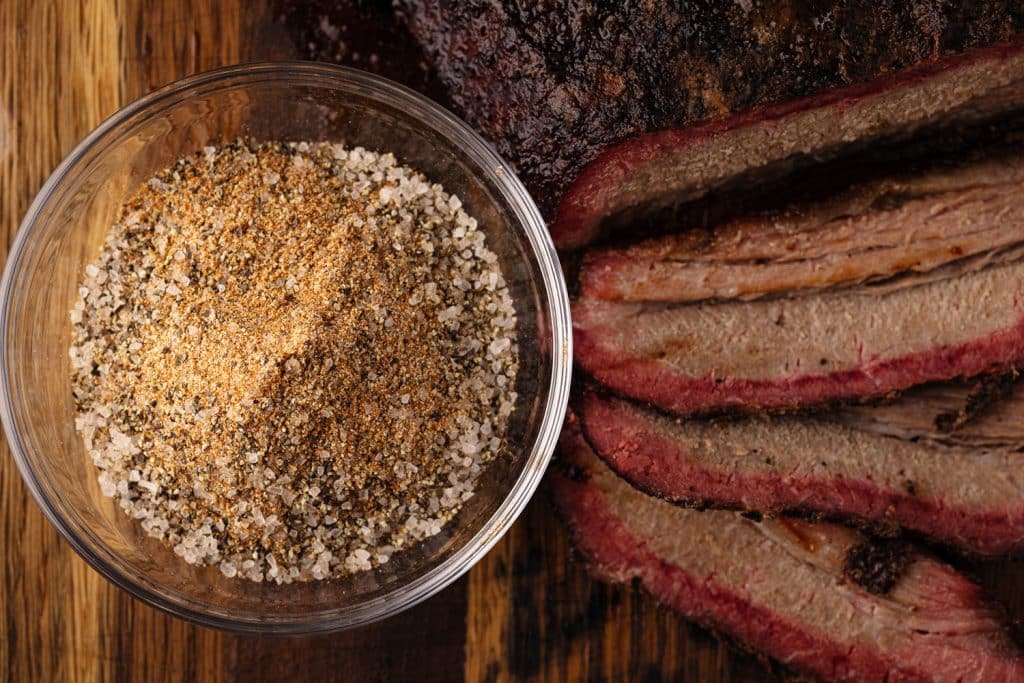Brisket is a classic Texas style barbecue with a devoted following of pitmasters. When prepared right, a smoked brisket has fork-tender meat and a beautifully caramelized bark. But the key to incredible brisket actually starts long before it even hits the smoker – it’s all in how you season it. A properly seasoned brisket transforms an already delicious cut of meat into the ultimate crowd-pleasing centerpiece.
In this comprehensive guide, we will walk through everything you need to know to perfectly season a beef brisket, from choosing the right brisket and prep work to making a simple yet flavorful brisket rub Whether you are a brisket rookie or longtime smoking enthusiast, follow these tips and your brisket will turn out mouthwateringly juicy and packed with flavor every time
Choose a High Quality Brisket
The foundation of a great brisket is sourcing excellent meat. Look for a whole untrimmed brisket, ideally USDA Prime or Choice grade beef with good marbling. The marbling provides internal bastes of fat that keep the brisket insanely moist and tender during the low and slow smoking process. Grass-fed brisket tends to be a bit leaner. For the best brisket, it’s worth seeking out high quality grain finished beef from a local butcher shop.
For a medium sized gather, a 10 to 12 lb packer brisket is a good choice, which contains both the flat (leaner) and point (fattier) that will provide you with delicious burnt ends. Avoid pre-trimmed brisket as you miss out on those flavorful fat trimmings.
Trim Excess Fat
Some excess hard fat on the brisket does not render well during cooking and should be trimmed off. Leave about 1⁄4 inch of fat on the brisket, trimming anything thicker. The brisket trimmings can be reserved for making ground beef. Trimmed properly, the brisket meat will have nice marbling and bright red color peeking through.
Apply a Dry Brine
To really boost the flavor of brisket, it’s ideal to dry brine before applying any rub. Mix together 1 tbsp fine ground black pepper and 1⁄4 cup kosher salt. Generously coat the brisket on all sides with the salt and pepper mixture. Overnight dry brining will deeply season the meat and result in a better bark. For convenience, the brisket can be seasoned immediately before smoking but benefits from at least a few hours of sitting with the rub.
Make a Simple Brisket Rub
Homemade rubs are easy to whip up with common spices and take brisket to the next level. For Texas style brisket, all you need is:
- 2 tablespoons coarse ground black pepper
- 2 tablespoons kosher salt
- 1 tablespoon smoked paprika
- 1 tablespoon garlic powder
- 1 tablespoon onion powder
- 1 teaspoon ground cumin
Mix the dry ingredients until well blended. Feel free to tweak this basic brisket rub recipe with a dash of cayenne for heat or other spices like coriander or mustard powder to add complexity. Store extra rub in an airtight container.
Generously Apply the Rub
After dry brining, use your hands to massage a liberal amount of brisket rub all over the meat, covering both sides. Sprinkle any cavities or openings with more rub as well. You want the meat well coated in seasoning but not caked on. Let the seasoned brisket rest at room temperature to allow the rub to penetrate while the smoker heats up.
Allow the Rub to Permeate
Letting the brisket rub really permeate the meat is vital for full-flavored brisket. Once coated in the rub, refrigerate overnight or at least 2 to 4 hours. The salt in the rub will dissolve over time, tenderizing the brisket while the other spices infuse it with flavor. For convenience, brisket can be seasoned right before smoking but is enhanced by this marinating time.
Use High Quality Wood and Fuel
Choosing flavorful clean burning wood or bisquettes and quality charcoal are also a key part of making amazing brisket. Stay away from processed wood and opt for all natural flavorful hardwoods like oak, pecan, hickory, or mesquite for rich smoky flavor. Soaked wood chips work well too. Quality natural lump charcoal also beats briquettes.
Monitor Temperatures
Managing temperatures is essential to properly smoking a brisket low and slow, so invest in a good dual probe thermometer. Maintain a constant 225 to 250°F temperature in the smoker. Monitor for the brisket stall around 160°F and be patient. Ideal internal temperature for tender brisket is 203°F. At this point it’s ready to be tightly wrapped in butcher paper and rest before slicing against the grain.
Rest the Brisket Properly
Never skip this vital step of letting the brisket rest before slicing into it. Resting allows the juices to be reabsorbed for maximum tenderness and moisture. After removing from the smoker, wrap the brisket in butcher paper and let it rest in an empty cooler for at least 2 hours up to 4 hours until the internal temperature drops to around 140°F.
From quality meat selection to proper slicing technique, correctly preparing brisket takes some time and patience. But it’s worth it when you can share insanely delicious and tender smoked brisket with family and friends. We hope these brisket seasoning tips help you achieve smoky perfection. Master this quintessential Texas barbecue and you’ll have happy guests begging for more! Let us know if you have any special brisket seasoning tricks. And get ready for your next brisket to be the juiciest ever thanks to proper seasoning and low and slow smoking.

How to Make Brisket Rub
Once you have all the ingredients assembled you’re ready to make this brisket rub! It’s so ridiculously easy to make rubs from scratch at home, and this one is no exception! Here’s how to make this brisket rub recipe.
- Combine. Combine all ingredients in a small bowl. Use a fork to evenly mix and break up any clumps that form.
- Use or store. This rub is ready to be used immediately, or you can store it for later use. I like to make my rub ahead of time so it’s ready to go when I make my brisket. I store all my homemade rubs and seasonings in these glass spice jars and they fit right in with my store-bought seasonings.

This rub is made to perfectly compliment the low and slow smoked flavor of beef brisket. Check out these recipes below to begin smoking a brisket.
How do you make brisket rub?
This recipe is a blend of brown sugar and spices. The flavor profile includes two types of paprika, salt, pepper, garlic powder, onion powder and mustard power. Simply measure out the sugar and spices, then stir to combine. Use your rub right away, or store for later use.
BEAUTIFUL BARK! | Simple, Delicious Brisket Rub – How To
FAQ
What should I season my brisket with?
-
Over The Fire Cookinghttps://overthefirecooking.comTexas Smoked Brisket Recipe – Over The Fire CookingMay 23, 2022 — Seasoned with Salt & Pepper: Traditionally speaking, Texas Smoked Brisket is seasoned with just Kosher Salt & Black Pepper on the surface of the mea…
-
Hey Grill, Heyhttps://heygrillhey.comTexas Style Smoked Beef Brisket [with Video]Apr 15, 2025 — Seasoning your Brisket Texas style is seasoned with only coarse salt and coarse black pepper. My only addition (and this is personal preference, you…
What is the 3 2 1 rule for brisket?
-
1. 3 Hours Unwrapped:Start by smoking the brisket at 225°F (107°C) for 3 hours, leaving it unwrapped to develop a flavorful bark.
-
2. 2 Hours Wrapped:After 3 hours, wrap the brisket in foil and continue smoking for another 2 hours at 225°F (107°C). This stage allows the brisket to become more tender and moist.
-
3. 1 Hour Unwrapped:Finally, unwrap the brisket and cook it for 1 more hour at 225°F (107°C) to crisp up the bark.
-
4. Rest:Allow the brisket to rest for at least 30 minutes before slicing and serving. This allows the juices to redistribute, resulting in a more tender and juicy final product.
What is the secret to juicy brisket?
Not too Slow: Smoking brisket at medium-low heat (250-265°F) ensures that the meat breaks down beautifully for tenderness without taking an extreme amount of …Aug 28, 2023
Should I rub or marinate brisket?
A dry rub, not a marinade
But low, slow cooking does that, too, so no need to marinate when you’re smoking brisket.
